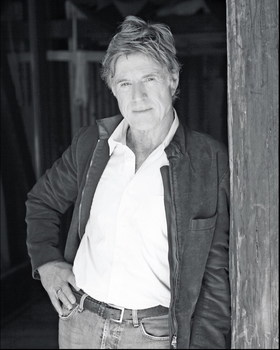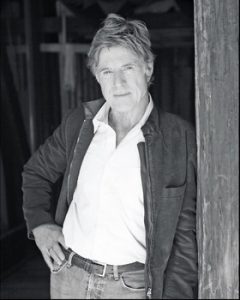“We need to get away from preciousness, of having everything right.”
– Robert Redford
All competent writers keep a morgue file – a stockpile of information that may someday be useful. Such files contain old magazine articles, newspaper clippings and more. Non-writing cynics may not see the value of such accumulations, but morgue files become truly valuable when you’re seeking an idea or reference.
Unfortunately, my morgue file sometimes grows from my file drawers to the desk and then across the floor. Like kudzu. Still, it’s useful. For example, it contains a September 2003 issue of Inc. magazine, where, on page 62, writer and business consultant Stephen H. Zades interviewed Robert Redford.
I met Robert Redford in Colorado, some years back. He was driving a copper-colored (metal-flake), Porsche 911 (it tended to oversteer, he said). Thus, we became instant, although passing, friends. We were both visiting the Aspen International Design Conference. Redford was collaborating on a film with Saul Bass (1920-1996), an Academy Award-winning designer. He and I sat together as Bass lectured on graphic design and his film projects; later we talked Porsches.
Bass created more than 50 film-title sequences for Otto Preminger, Alfred Hitchcock, Stanley Kubrick, John Frankenheimer and Martin Scorsese; he also designed numerous logos, including those for Bell Systems, United Way, Continental and United Air Lines. (See a collection of his outstanding poster designs at www.cinemacom.com/saul-bass.html.)
Bass said he was self-taught because, when he began, there were no design schools. Design, then, was called commercial art, and few classes existed. He took a painting class at the start of his career.
Advertisement
In the Inc. interview, Redford spoke of his Sundance enterprise and the unconventional efforts that created it. Altogether, Sundance is many enterprises – it includes a resort, DVD/video line, catalog-sales business and a nonprofit institute that comprises various creative workshops. Best known perhaps, is the Sundance Film Festival.
Today, Sundance is a leading institute for inspiring independent films and has been involved in making more than 85 films, including Raising Victor Vargas, Boys Don’t Cry and Reservoir Dogs. The enterprise began in 1961, with two acres, 24-year-old Redford’s hand-built cabin and his belief in a grander place.
Bass believed that design is thinking made visual. He also admitted to having an obsessive nature and related himself to Stanley Kubrick, who, he said, was an extraordinarily obsessive person. In a 1996 interview, Bass said, “…the people who work for me think I’m a little ‘meshuga’ [crazy].”
Crazy? Or was it passion?
In his interview, Zades said Redford fervently exclaimed, “Do you believe the earth was created by an accountant?” He answered himself: “The earth was created by the combustion of a creative explosion. Fire and chaos started everything. Then order came on top of that.”
Advertisement
Passion.
Redford said business growth is not an accounting practice, but a creative process. His muses include Steve Jobs, Yvon Chouinard (Patagonia) and Paul Hawken (Smith & Hawken) because they understand business and the role of the creative.
In the interview, Bass spoke of dealing with film director Otto Preminger (1906-1986), who, he said, had true artistic vision and the clout to pull it off. He complained that many directors have clout, but not graphic vision, and, although they care for advertising (visuals), they don’t start with a point of view.
He said, “You can see the result in the state of film graphics and advertising today. In many cases, the advertising is quite effective, but ultimately unmemorable.”
Zades is the co-founder of The Odyssey Project, an organization that studies innovative leaders and brings creative – and future-lensed thinking patterns – into business. In a Fast Company interview, Zades told of advancing a client’s thinking by taking him to see a Guggenheim exhibit that mimicked the human brain – a wall with 1,000, computer-linked televisions. In this constantly changing array, Zades said, were graphically presented “big thoughts” that would swell up and dominate the screens, but, accompanying these, were lesser thoughts which floated in and out of leftover spaces.
The client was unimpressed.
Advertisement
Zades then took the client to New York City’s NikeTown, where, on one wall, 50 television screens broadcast quick-changing ads and images. (Today, it has large-format LCD screens.)
“There we were,” Zades said, “at the leading edge of retail. And the display couldn’t hold a candle to the Guggenheim exhibit – which was 10 years old!”
Zades’ client was now impressed. A Guggenheim artist had, by 10 years, foreshadowed coming marketing events. The lesson was obvious: Look into the creative realm for new ideas.



 Photo Gallery2 weeks ago
Photo Gallery2 weeks ago
 Ask Signs of the Times2 weeks ago
Ask Signs of the Times2 weeks ago
 Paula Fargo1 week ago
Paula Fargo1 week ago
 Real Deal6 days ago
Real Deal6 days ago
 Photo Gallery1 week ago
Photo Gallery1 week ago
 Women in Signs2 weeks ago
Women in Signs2 weeks ago
 Projects6 days ago
Projects6 days ago
 Women in Signs2 weeks ago
Women in Signs2 weeks ago










